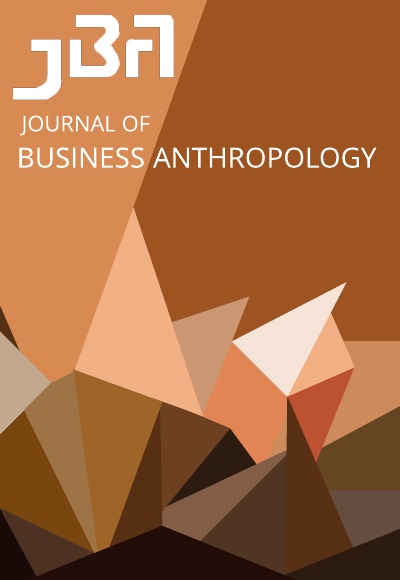Vacuums with Meaning: The Observation of Vacuity in Coworking Spaces
DOI:
https://doi.org/10.22439/jba.v13i2.7402Abstract
This field report analyzes the unexpected challenges faced during participant observation in coworking spaces and how these challenges required a process of trial and error to be understood. Between 2018 and 2022, I studied the urban transformation of the Poblenou district of Barcelona, Spain. During my ethnographic observations, the coworking spaces did not align with the criteria of collaboration and social density established by previous research. This finding prompted methodological reflections on the role of ethnography, emphasizing the need to acknowledge that ethnographic research does not follow a standard formula, but rather requires continuous adaptation and interest in the evolving empirical reality.
References
Bandinelli, C. (2020). “The Production of Subjectivity in Neoliberal Culture Industries: The Case of Coworking Spaces.” International Journal of Cultural Studies 23(1): 3-19. https://doi.org/10.1177/1367877919878449
Bennis, W. M. and Orel, M. (2024). “Taboo Trade-Offs in the Community Business: The Case of Coworking.” Journal of Management Inquiry 33(1): 77-91. https://doi.org/10.1177/10564926231187292
De Guzmán, G. V. and Tang, A. (2011). Working in the Unoffice: A Guide to Coworking for Indie Workers, Small Businesses, and Nonprofits. United States: Night Owl Press.
Gandini, A. (2015). “The Rise of Coworking Spaces: A Literature Review.” Ephemera 15(19): 193-205.
Gandini, A. and Cossu, A. (2021). “The Third Wave of Coworking: ‘Neo-Corporate’ Model Versus ‘Resilient’ Practice.” European Journal of Cultural Studies 24(2): 430-447. https://doi.org/10.1177/1367549419886060
Garsten, C. (1991). “Outlining the Organization – Creating Culture Across Boundaries.” Zeitschrift für Ethnologie 116: 5-24.
Hannerz, U. (1996). Transnational Connections: Culture, People, Places. London and New York: Routledge.
Ho, K. (2012). “’Studying Up’ Wall Street: Reflections on Theory and Methodology.” In L. Aguiar and C. Schneider (eds.), Researching amongst Elites: Challenges and Opportunities in Studying Up (pp. 29-48). London and New York: Routledge.
Merkel, J. (2015). “Coworking in the City.” Ephemera 15(2): 121-139.
Mörck, M. and Casabella, T. (1994). “El Silicon Valley de Göteborg.” Historia y Fuente Oral 11: 145-164.
Orel, M., Mayerhoffer, M., Fratricova, J., Pilkova, A., Starnawska, M., and Horvath, D. (2022). “Coworking Spaces as Talent Hubs: The Imperative for Community Building in the Changing Context of New Work.” Review of Managerial Science 16(5): 1503-1531. https://doi.org/10.1007/s11846-021-00487-4
Rabinow, P. (1977). Reflections on Fieldwork in Morocco. Berkeley: University of California Press.
Spinuzzi, C. (2012). “Working Alone Together: Coworking as Emergent Collaborative Activity.” Journal of Business and Technical Communication 26(4): 399-441. https://doi.org/10.1177/1050651912444070
Waters-Lynch, J., Potts, J., Butcher, T., Dodson, J., and Hurley, J. (2016). “Coworking: A Transdisciplinary Overview.” Social Science Research Network, Rochester. https://doi.org/10.2139/ssrn.2712217
Yacoub, G. and Haefliger, S. (2024). “Coworking Spaces and Collaborative Practices.” Organization 31(1): 87-114. https://doi.org/10.1177/13505084221074037
Downloads
Published
Versions
- 2025-04-30 (2)
- 2025-04-04 (1)
Issue
Section
License
Copyright (c) 2024 Josep Puigbó Testagorda

This work is licensed under a Creative Commons Attribution-NonCommercial-NoDerivatives 4.0 International License.
Authors who publish with this journal agree to the following terms:
- Authors retain copyright and grant the journal right of first publication with the work simultaneously licensed under a Creative Commons Attribution License that allows others to share the work with an acknowledgement of the work's authorship and initial publication in this journal.
- Authors are able to enter into separate, additional contractual arrangements for the non-exclusive distribution of the journal's published version of the work (e.g., post it to an institutional repository or publish it in a book), with an acknowledgement of its initial publication in this journal.
- Authors are permitted and encouraged to post their work online (e.g., in institutional repositories or on their website) prior to and during the submission process, as it can lead to productive exchanges, as well as earlier and greater citation of published work (See The Effect of Open Access).



